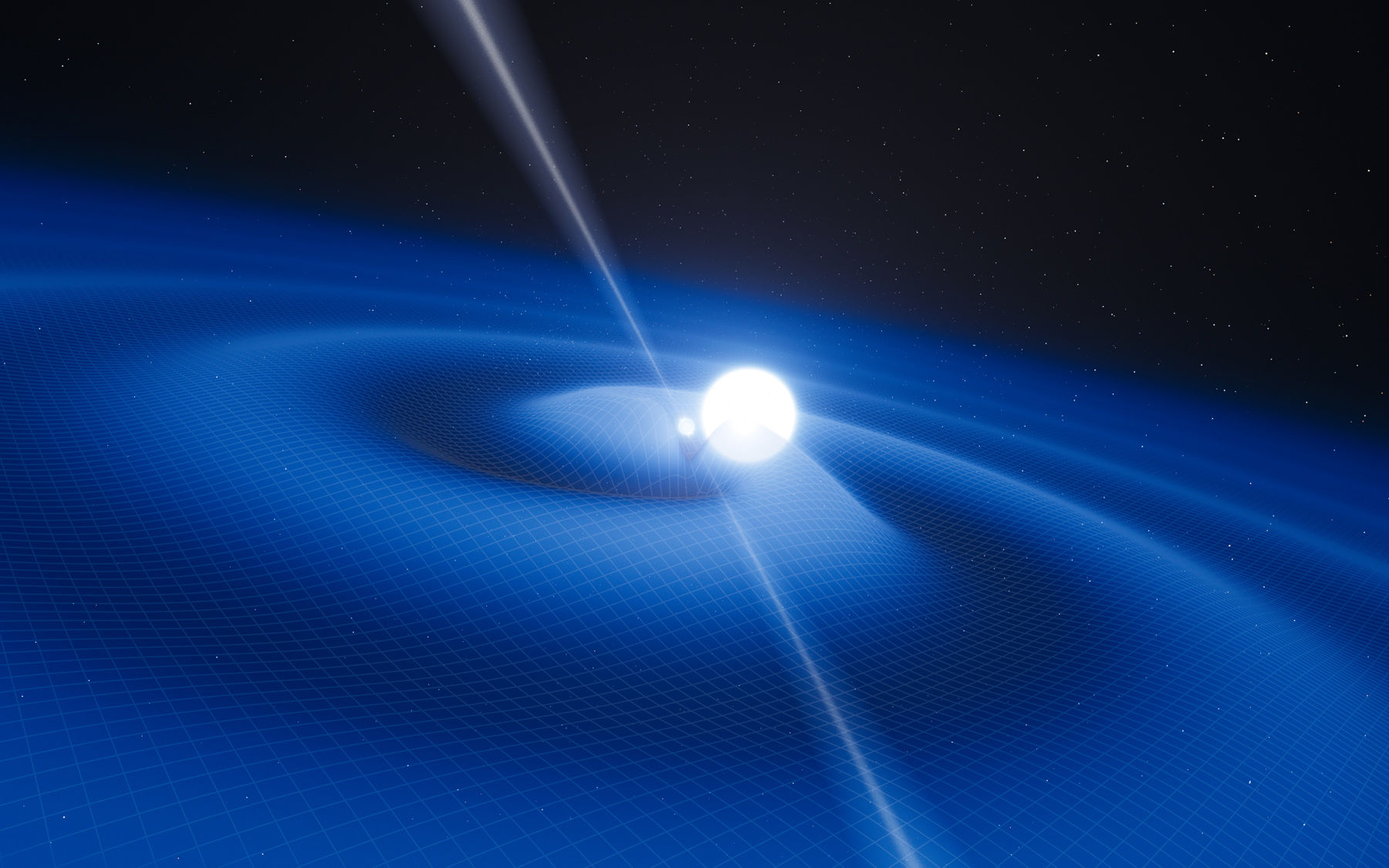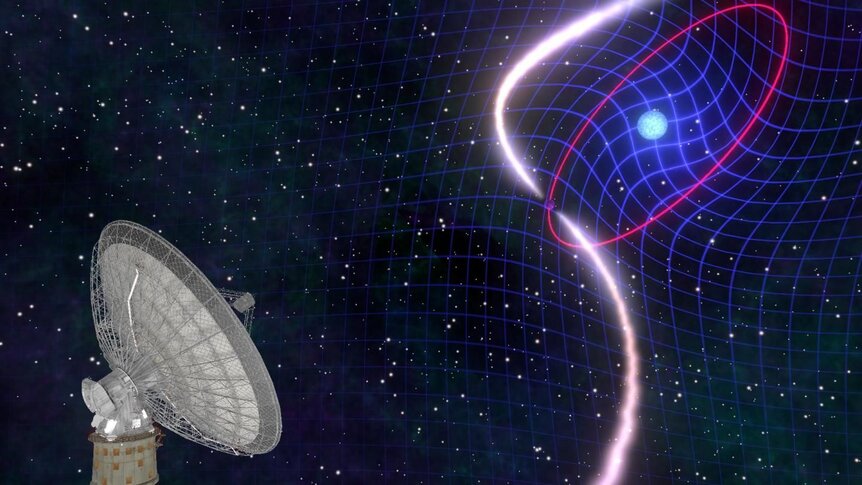Create a free profile to get unlimited access to exclusive videos, sweepstakes, and more!
A dead star's spin is dragging the fabric of spacetime along with it

After observing a binary system of two dead stars for 20 years, astronomers have detected the very subtle effect of Einstein's hand: Frame-dragging, an outcome of General Relativity where a rapidly spinning massive object literally drags the fabric of spacetime around it, winding it up like a thread around a spindle.
Every single step of this science is bizarre and astonishing and oh-so-cool. Let's go through 'em.
The binary system is a pulsar (called PSR J1141-6545) and a white dwarf orbiting each other. A white dwarf is the leftover core of a star similar to the Sun after it dies. It sheds its outer layers, revealing the hot dense core: A ball the size of the Earth but with the mass of a star.
A pulsar is similar, but colossally more violent. It's the leftover core of a much more massive star that has exploded as a supernova. The explosion ejects the outer layers rapidly and catastrophically, while the core collapses to become a ball of neutrons maybe 20 kilometers across but even more massive than a white dwarf. We call such an object a neutron star. They sometimes emit beams of radiation from their poles, and as they spin these sweep across space like the beams from a lighthouse. From Earth we see this as a blip of light when the beam passes over us, pulsing. Hence the term pulsars.
A white dwarf has so much mass in a volume so small that its density is a few hundred thousand times the Earth's, around a million grams per cc, a million times the density of water. A neutron star, on the other hand, is more massive and smaller, so its density is ridiculous: A hundred trillion times that of water. A cubic centimeter of neutron star material would weigh as much as all the cars in the USA combined. So, yikes.
Weirdly, the observations indicate the white dwarf in the binary formed first. Usually, the more massive star explodes first, so you'd think the neutron star would be older. But this system is weird. It started out as two normal stars orbiting each other, one slightly more massive than the other. Both were just below the mass limit needed to explode as a supernova (around 8 times the mass of the Sun) and create a neutron star. The more massive one died first, expanding into a red giant, shedding its outer layers, and leaving behind a white dwarf. But when it expanded it dumped a lot of material onto the other star. That second star grew more massive, enough to explode and create a neutron star! Like I said, weird.
So then we have this brain-meltingly massive binary, a neutron star pulsar and a white dwarf. The pulsar spins about 2.5 times per second, which is slow for such a beast. But the white dwarf spins in less then three minutes, which is actually very fast for a white dwarf. Likely what happened is that the second star, before it exploded, expanded into a red supergiant and dumped material onto the white dwarf. This matter fell onto the white dwarf and spun it up, giving it the current rapid rotation rate (this is how they know the white dwarf formed first; if the neutron star had formed first then the other star would've dumped material onto it later, spinning it up. The neutron star spins slowly, so that cannot be the case).
Here's where things get fun. A pulsar is an incredibly accurate clock. Those pulses we observe are tied to its rotation, and when you have such a massive rotating beast, the spin is incredibly stable. Those pulses arrive with the same period to an accuracy measured in nanoseconds!
However, they do change. The astronomers observed this system for 20 years, and detected a change in the pulse period. This is expected; pulsars slow their spin over time (called spin down), but it's an incredibly small effect. But the change in the pulses means others things are changing as well. Because the two dead stars orbit each other, sometimes the pulsar is moving toward the Earth in its orbit, and sometimes away. This bunches the pulses up for half the orbit and spreads them out for the other half, changing the timing of when the pulses arrive at Earth. This can be measured, too, giving the orbital period of the system to phenomenal accuracy (in this case, 0.1976509615 days, or 4.743623076 hours). Other aspects of the orbit can be found as well.
… but. Over the decades of observations they found that the orientation of the orbit was changing. It was wobbling, like a top as friction with the tabletop slows it. This motion is called precession, and can be caused by a couple of different things. One is that the two stars aren't exactly spherical. Because they spin so rapidly, they bulge at their equators due to centrifugal force. The two stars equators don't align, so each star's bulge tugs on the other one, causing a torque. This is called — and I can't tell you how much I love this phrase— Newtonian quadrupole spin–orbit coupling. It's just a normal effect of having non-spherical bodies orbiting each other; this happens with the Earth and Moon and causes our days to very gradually get longer.
But even accounting for that there's still a drift in the orbital orientation in space. That's the weird relativistic effect! It's called the Lense-Thirring effect, after two physicists who first figured out that it was a consequence of General Relativity.
I wrote about this effect before, when it was detected around a black hole:
Black holes are known for their intense gravity of course, which can apply a huge force to material around it. But it turns out anything with gravity warps spacetime — that's what gravity is, a dent in the fabric of space and time — and if that object is also spinning, it tugs on spacetime, wrapping it around itself. It's another weird outcome of General Relativity.
Think of it like a bowl with honey in it. If you put a ball in the honey and spin it, it will drag the honey around with it due to friction. The stuff very close to the ball moves faster than stuff farther out. The same thing happens with a spinning object in space; the space nearest the object will be dragged along with the spin. This is called the Lens-Thirring Effect, or more colloquially, and more colorfully, frame dragging.
This effect has been measured around Earth, but it depends on the mass of the object and its spin rate, which are both much higher with dead stars. In the case of this binary system, white dwarf's drag is something like a hundred million times the effect the Earth has! This is what's changing the orientation of the orbit of the two stars, and therefor the timing of the pulses. While it has been detected in other astrophysical sources before, it's never been seen in quite this way. So that's nifty.
And it's another "proof" of the reality of relativity, which we can throw on the pile with the hundreds of others. General Relativity is one of the best-supported ideas science has ever had, despite the weird nature of its predictions.
This pulsar/white dwarf observation was painstaking. First they had to observe the system for decades, then work out a ton of characteristics of the two stars, then account for a lot of other things that can interfere with the calculations. What they had left was a subtle variation that indicated monumental forces were at work very delicately, ones that could shift the way two of the Universe's heavyweights interact with each other over decades' time, and it all comes down to space being a thing, something that can be warped and rippled and, in this case, twisted up.
So like I said: Bizarre. Astonishing, And oh, so cool.

















